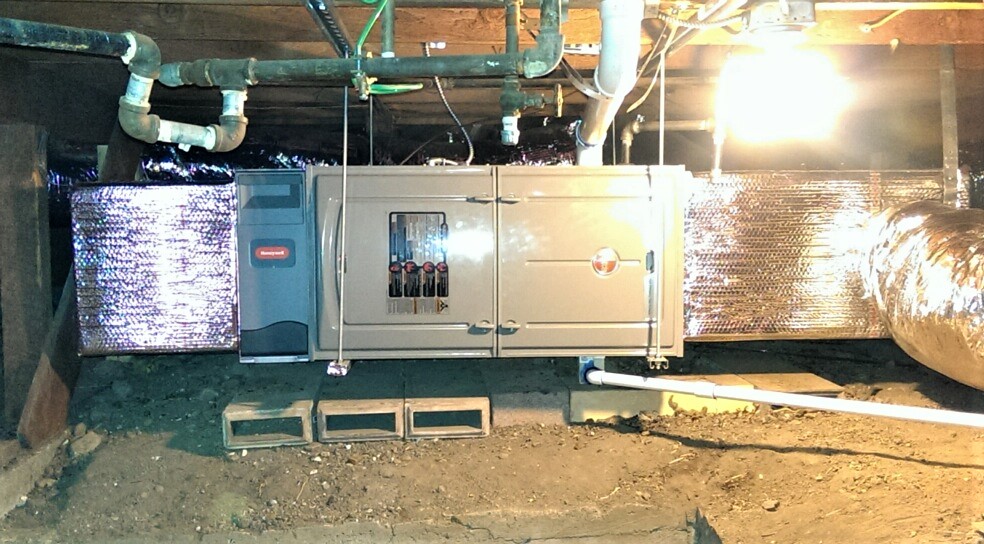
From wildfire smoke to COVID-19, Californians have faced numerous airborne contamination threats in 2020. And while staying indoors can mitigate these threats, they sometimes still manage to breach our domestic borders. Perhaps you’ve had guests in your home (expected or otherwise), or maybe your home isn’t well-insulated from the outside air. In either case, it’s possible that the air quality in your home has (or will) become compromised.
One measure you can take to mitigate this risk is utilizing an air purification device, whether a portable unit or an add-on to your home’s HVAC system. However, when it comes to choosing an air purifier, it can be difficult to know which is the right fit. Read the following to learn about your air purification options, how they differ and what to consider when purchasing one.
Portable air purifiers
Portable air purifiers (aka air cleaners) are standalone units that can be placed anywhere in the home. These units actively clean the air by cycling it through their internal filters and capturing airborne particles. Naturally, a single air cleaner can’t effectively filter the air throughout an entire home, which is why some homeowners choose to purchase multiple units.
But how effective are these portable air cleaning units? This varies by individual model, each of which has a specific design and capabilities. Naturally, a cheaper model may not provide the same level of performance as a more expensive model. That’s why it’s important to look at a model’s specifications, not just its price tag. Here are some characteristics to look for in a portable air purifier:
1. True HEPA filter
True HEPA filters are rated to be able to remove 99.97% of particles that are 0.3 micrometers and larger. This includes mold spores, pet dander, dust, pollen, and larger smog and smoke particles. They’re called “True” HEPA filters to differentiate them from copycat filters that advertise as “near-HEPA” or “HEPA-style.” Most of those filters can remove 99% of particles 2.0 micrometers and larger in size—nowhere near as effective as a True HEPA filter.
2. Activated carbon filter
Activated carbon filters are composed of small pieces of carbon that have been treated to be extremely porous. They have a unique ability to capture volatile organic compounds (VOCs) and odors that True HEPA filters cannot, including those found in wildfire smoke.
3. UV light
UV light has the unique ability to kill microorganisms like viruses and bacteria, which are too small for True HEPA filters to capture. Keep in mind that the light spectrum must be between 200 and 400 nanometers (nm) to work effectively.
While these characteristics can be found individually in air purifiers, you can also find models that incorporate several of them together. Eureka’s 3-in-1 Air Purifier is a great example of this—it combines all three of the aforementioned characteristics to maximize filtering effectiveness. Some air cleaners also have ionizers, which break up pollutants into negative ions. However, since ionizers produce ozone as a byproduct, this feature is becoming less popular.
Whole-home air purification
There are several types of whole-home air purification devices. Most are incorporated into and work in conjunction with the home’s HVAC system to purify air as it circulates through the ducts. A couple of popular products are PureAir by Lennox (which combines hospital-grade filtration and UV light) and Air Scrubber by Aerus (which uses proprietary ActivePure® Technology created in cooperation with NASA). Both products showcase the extraordinary technological innovations that have taken place in the air quality and HVAC industries in recent years.
Despite the impressive technology, there are some potential drawbacks to the whole-home approach to air purification.
1. Cost
Since they must be integrated into the existing HVAC system, whole-home air purification systems are often very costly to install. For example, PureAir typically costs $700 to $800 for the equipment, while the installation costs can range from $1,200 to $2,500. You also need to factor in annual maintenance costs—a kit that includes replacement filters and UV bulbs typically costs $150 to $200.
2. Practicality of application
While it may seem like a good idea to add air-cleaning capabilities to your HVAC system, it’s not necessarily the most practical approach. The fact is, forced-air HVAC systems aren’t designed for air purification. In order for an air purification device to be fully effective, the system’s fan must run continually to keep air cycling through the home. Not surprisingly, this can lead to increased energy costs. Other aspects like style and design can also impact the effectiveness of a whole-home air purification device.
3. Filtration limitations
Another drawback of the whole-home approach is that you can’t get True HEPA-grade filtration. This is because residential HVAC systems don’t provide enough airflow to compensate for the air restrictions imposed by True HEPA filters. So, although whole-home air purification systems may be effective at removing allergens like dust and pet dander, they’re unable to capture the small, 0.3 micron particles that a True HEPA filter can.
This isn’t to say these devices won’t improve your home’s air quality—most likely, they will. For example, adding a UV light to your HVAC system will reduce air contamination risks by killing microorganisms like bacteria and viruses. Even though it won’t filter out wildfire smoke, it could help mitigate the threat of COVID-19 in your home.
The bottom line
If wildfire smoke is your main concern, one or more high-quality portable air cleaners is probably your best solution. Not only are they more affordable than a whole-home addition, they’ll be more effective at combating smoke. On the other hand, if you want to invest in a whole-home option to make your home’s air cleaner and more sanitary, there are some great products that can do that for you. For more information on indoor air purification options, consult a licensed indoor air quality specialist.
Learn more about the differences between portable air purifiers and whole-home units
